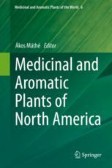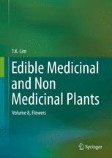Search
Search Results
-
The role of petal transpiration in floral humidity generation
Main conclusionUsing petrolatum gel as an antitranspirant on the flowers of California poppy and giant bindweed, we show that transpiration provides...

-
Alien Vascular Plants of the Republic of Mordovia: Modern Composition and Its Changes over the Past Two Decades (2000–2020)
AbstractThe first inventory of alien species in the Republic of Mordovia was conducted in 2000. The article provides information on changes in the...

-
Role of Jasmonic Acid and Salicylic Acid Signaling in Secondary Metabolite Production
Secondary metabolite synthesis takes place from primary metabolites. Secondary metabolites have no role in the development of plant growth,...
-
Floral infrared emissivity estimates using simple tools
BackgroundFloral temperature has important consequences for plant biology, and accurate temperature measurements are therefore important to plant...

-
Hairy root induction and benzylisoquinoline alkaloid production in Macleaya microcarpa
Macleaya microcarpa are rich in benzylisoquinoline alkaloids (BIAs). Hairy roots can effectively produce natural secondary metabolites. A reliable...

-
Pharmacopoeial Wild Medicinal Plants of North America
In the time since the first publication of the Pharmacopoeia of the United States of America in 1820 and of the first edition of Farmacopea Mexicana...
-
RNA Interference Technology as a Novel and Potential Alternative for Plant Improvement
RNA interference (RNAi) is a versatile and powerful technique, which is routinely being used to down-regulate specific target genes in different...
-
Comprehensive inventory of cannabinoids in Cannabis sativa L.: Can we connect genotype and chemotype?
Following decades of tight restrictions, recent legislative adjustments have decriminalized the use of products derived from cannabis ( Cannabis sativa ...

-
Genetic Resources of Medicinal and Aromatic Plants
Medicinal and aromatic plants comprise a huge number of plant species worldwide. Around 70,000 species are in use for medicinal purposes in a broader...
-
Theoretical models for branch formation in plants
Various branch architectures are observed in living organisms including plants. Branch formation has traditionally been an area of interest in the...

-
Natural enemy enhancement and botanical insecticide source: a review of dual use companion plants
Intensive agriculture, which is associated with heavy inputs of synthetic insecticides, has serious ecological impacts, leading to loss of vital...

-
Genetic Engineering Potential of Hairy Roots of Poppy (Papaver spp.) for Production of Secondary Metabolites, Phytochemistry, and In Silico Approaches
Opium poppy is one of the most important medicinal plants, because of its secondary metabolites (alkaloids). Opium as such is an important product,...
-
The potential of culinary vegetable oils as herbicides in organic farming: the effect of oil type and repeated applications on plant growth
This study tested the herbicidal effects of raw and processed culinary oils (rapeseed oil, sunflower oil, olive oil, flax/linseed oils) on nine plant...

-
Biodiversity Mining Through Transcriptome Analysis
Secondary metabolites or chemical constituents of plants are functional products synthesized through more complex multienzymatic secondary metabolite...
-
The developmental and genetic bases of apetaly in Bocconia frutescens (Chelidonieae: Papaveraceae)
BackgroundBocconia and Macleaya are the only genera of the poppy family (Papaveraceae) lacking petals; however, the developmental and genetic...

-
Attachment of honeybees and greenbottle flies to petal surfaces
Flower surfaces play a key role in the interaction with pollinators acting as signals and landing sites to attach to. To test attachment, Carniolan...

-
Effect of light and auxin transport inhibitors on endoreduplication in hypocotyl and cotyledon
Key message Enhancement of endoreduplication in dark-grown hypocotyl is a common feature in dicotyledonous polysomatic plants, and TIBA-mediated...

-
Self-regulation of phytoalexin production: a non-biosynthetic enzyme controls alkaloid biosynthesis in cultured cells of Eschscholzia californica
Benzophenanthridine alkaloids are strong antimicrobials of Papaveraceae and attractive lead compounds for drug development. The cytotoxicity of these...

-
New Manual of Vascular Plants of Northeastern United States and Adjacent Canada
The New Manual of Vascular Plants of Northeastern United States and Adjacent Canada is an active project by New York Botanical Garden building upon...

-

